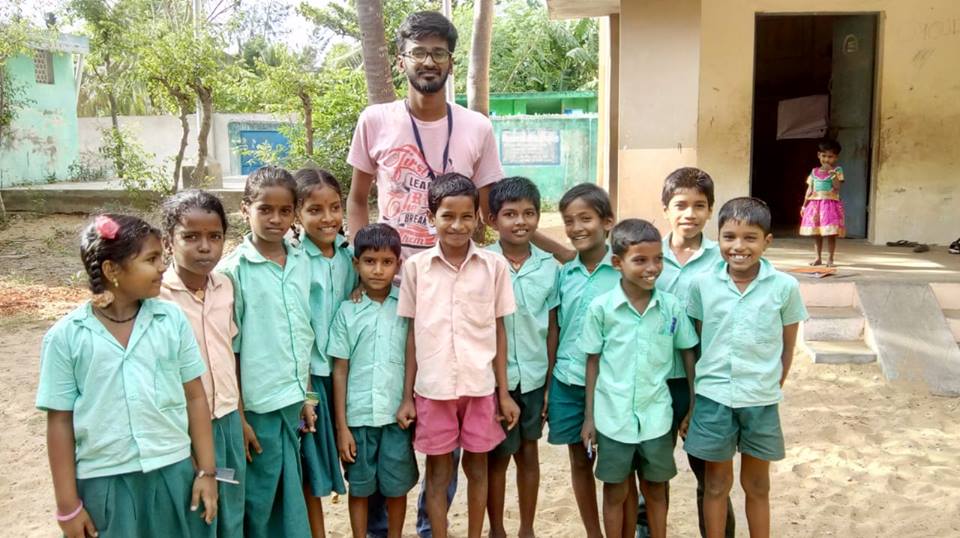August, 2018
Anupam and Kishore were the June-July batch of students who interned at FIN. They successfully completed their internship with Friend In Need India and came up with the final version of their respective research reports. It was really exciting to work with such young minds, touching new subjects to connect with the village. The lads made many interesting observations about Kameshwaram during their internship. The following posts provide a summary of their observations.
PART 1:
Designing cost-effective rainwater harvesting system in the village of Thirupoondi (near Kameshwaram)
Anupam worked on designing an economic solution to the water scarcity problem faced by the people of Thirupoondi. The village has ponds which the people use for washing, bathing and other domestic needs. But the challenging problem is getting water for drinking. The groundwater table is low and the water has high salinity.  This forces people to get water from the temple pipes which are the only source of drinking water. To make things worse, this is accessible for only 45 minutes a day and due to the higher population, it becomes difficult for all to avail it.
This forces people to get water from the temple pipes which are the only source of drinking water. To make things worse, this is accessible for only 45 minutes a day and due to the higher population, it becomes difficult for all to avail it.
One of the interesting discoveries is that this village receives the highest rainfall in the state, yet it faces water scarcity. This made us curious and we interacted with a variety of stakeholders including the Block Development Officer, Assistant Engineer of Nagapattinam and most importantly the people of Thirupoondi. These focus group discussions and meetings helped us figure out the reason for the issue. The village can be divided into two zones – West Thirupoondi and East Thirupoondi. Water scarcity is mainly faced in the west zone of the village. This is attributed to the texture of the soil in the two regions. East Thirupoondi’s soil is sandy in nature that aids water percolation while the other region has clayey sand leading to more water retention at the top layer and less percolation. This explanation gave a clear picture of the issue and helped us in designing a solution for this.
We explored if there are any systems currently in place for harvesting rainwater. It was found that some houses had  simple rainwater harvesting solutions like directing the rainwater to a well of 20 feet deep. Then we turned towards community-based systems. The government has installed a soak pit and an RO plant, which are non-functional and in a very poor state. The interaction with the Assistant Engineer proved fruitful. He gave us some technical details about the soak pit and the RO plant, which were built as a result of two different government schemes. He remarked
simple rainwater harvesting solutions like directing the rainwater to a well of 20 feet deep. Then we turned towards community-based systems. The government has installed a soak pit and an RO plant, which are non-functional and in a very poor state. The interaction with the Assistant Engineer proved fruitful. He gave us some technical details about the soak pit and the RO plant, which were built as a result of two different government schemes. He remarked  that the RO plant gets water through two bore wells and desalinates it. The groundwater levels are currently very low rendering the RO plant useless. The soak pit was apparently damaged by few anti-social elements, limiting its functionality.
that the RO plant gets water through two bore wells and desalinates it. The groundwater levels are currently very low rendering the RO plant useless. The soak pit was apparently damaged by few anti-social elements, limiting its functionality.
The focus group discussions and interviews shed light on this issue from people’s perspective. Though everyone acknowledges the problem and identifies it as one of the major challenges of the village, only 50% are willing to get involved in solving this issue. This is because of the cost involved and people are waiting for the local panchayat to address this issue with a community-based solution.
Based on all the data collected over a month’s time and considering the pros and cons of each model, a low-cost individual house based water-harvesting system was proposed. Half-cut PVC pipes could be used to direct the water from roof-tops to a water tank which can be used later. A rough estimate pointed out that it would cost about Rs. 12000 for installing such a water-harvesting system, which is very affordable given the problems the people face. People spend a good amount of their time in fetching water and this could be put to better use, if there is a water harvesting system in place.
Do you have any interesting suggestions? We would love to hear from you.
 PART 2: Innovation in Classroom Learning Strategies
PART 2: Innovation in Classroom Learning Strategies
This interesting project on shaping up the school children, in the long run, was taken up by Kishore. His ability to interact well with the kids and the teachers gave us a wonderful perspective on the existing problem and how to overcome them. Six schools (most of which are primary schools) in the village were selected for this action research project. A detailed database containing all the information of the schools was prepared. This gave us an insight into how big the schools were in terms of classrooms, student-teacher ratios, textbooks used, their timetables, etc. Kishore spent a  day in each school attending the classes along with the students to observe the environment.
day in each school attending the classes along with the students to observe the environment.
One of the interesting discoveries made in this internship was that none of the schools promote physical activities in any form. This was very shocking and it seriously raised questions on the type of education we are providing to these children. Due to lack of space in some schools, multiple classes are conducted in the same classroom simultaneously, leading to distraction. This can be as bad as students of four different standards utilizing the same classroom. The students are able to concentrate for a maximum of 30 minutes. Classes generally go beyond that, which makes it difficult for kids to concentrate. Due to the shortage of teachers in some schools, they are forced to handle all the subjects of various classes. This, in turn, leads to skipping a few sessions along the way. A couple of schools did not even have toilets for children, who were forced to go home or to nearby places to use a toilet. On a positive note, one of the schools has a television which is used to create awareness on sanitation and hygiene. Another interesting teaching tactic used in one of the government schools is teaching in the ground with live objects like leaves and flowers to help the students understand the subject better.
Focus Group Discussions were conducted with the teachers of these schools. This provided us with some valuable information. The teachers feel that parents’ involvement play a vital role in a student’s performance at school. The students are also deeply affected by the environment of their homes. Male members of the household fighting with others under the influence of alcohol seems to be a major issue affecting the kids. We observed that students are open to learning new things. They just need guidance and a slight tweak in the learning strategies. Fun interventions for students could definitely help them explore new ways to learn social lessons. We proposed this to the teachers and they really loved the concept. They were very open to implementing it in their schools.
In the next phase of the internship, Kishore worked with the FIN staff to come up with a protocol for the interventions. The classes would be divided into two. One half would get to experience an interactive session in the  classroom starting with stretches, meditation and proceeding to storytelling, discussing a banner promoting good practices and other art-related activities. The other half of the class would go on a trash walk, where they would learn about the different varieties of waste, the importance of segregation and few games related to waste management. The banners used to discuss during the intervention were also designed and printed. The intern along with the FIN field members had a pilot session in one of the schools. This was received very well by the students and teachers alike. They were very excited about the session and were looking forward to the upcoming ones.
classroom starting with stretches, meditation and proceeding to storytelling, discussing a banner promoting good practices and other art-related activities. The other half of the class would go on a trash walk, where they would learn about the different varieties of waste, the importance of segregation and few games related to waste management. The banners used to discuss during the intervention were also designed and printed. The intern along with the FIN field members had a pilot session in one of the schools. This was received very well by the students and teachers alike. They were very excited about the session and were looking forward to the upcoming ones.
Wasn’t that really interesting? We believe that creating an impact on the younger generation is the key to a better future. We have started this as a first step in achieving that. Please feel free to comment your views and suggestions on this initiative below!


